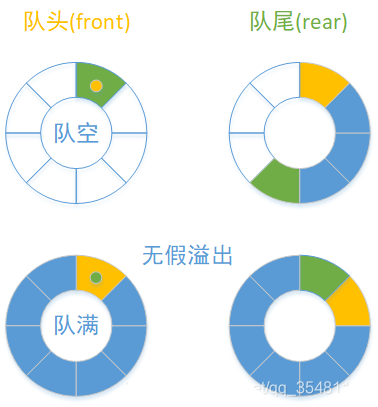数据结构实现(四):循环队列(C++版)
1. 概念及基本框架
通过第三节我们知道,数组队列 在出队操作中需要花费 O(n) 的时间复杂度,原因在于出队时需要移动大量元素。如果我们可以循环利用空间,那么问题就迎刃而解。所以,循环队列 应运而生。循环队列结构如下:
(这里为了直观,将队列绘制成环形,实际内存依旧是连续的内存块。)

首先循环队列作为队列的一种,基本特性和数组队列相同:
1.队列 有 队头 和 队尾 两端。
2.入队 操作只能从 队尾 进行,出队 操作只能从 队头 进行。
3.先 入队 的先 出队 ,即 先进先出(First In First Out),FIFO 。
还有一个隐含特性,队列可以自行 扩容(缩容),而不需要用户关心。
由上图结构可知,队空和队满时,队头和队尾都指向同一块内存。因为循环队列和动态数组有一定差异,所以对循环队列从底层重新进行了实现。首先,依旧使用一个由 纯虚函数 构成的 抽象类 作为一个接口来定义这些操作。具体代码如下:
template <class T>
class Queue{
public:
virtual int size() = 0;
virtual bool isEmpty() = 0;
virtual void print() = 0;
//入队操作
virtual void enqueue(T num) = 0;
//出队操作
virtual void dequeue() = 0;
//获得队首元素
virtual T front() = 0;
};
下面从底层重新构建一个循环队列类。
template <class T>
class LoopQueue : public Queue<T>{
public:
LoopQueue(int len = initialLen){
T *p = new T[len];
m_data = p;
m_capacity = len;
m_size = m_front = m_rear = 0;
}
...
private:
T *m_data;
int m_capacity;
int m_size;
int m_front;
int m_rear;
};
这个类内部定义一个数组,为了兼容更多类型,这里使用了泛型的概念。然后定义了队列的容量、大小以及队头和队尾。同理,构造数组时,可以初始化队列的队列容量,(默认是10)队头和队尾都是0。
与动态数组类似,为了实现自行 扩容(缩容),类内部创建了一个 resize 函数来实现。
template <class T>
class LoopQueue : public Queue<T>{
public:
...
void resize(int len){
T *p = new T[len];
if (m_size == 0){}
else{
for (int i = 0; i < m_size; ++i){
p[i] = m_data[(i + m_front) % m_capacity];
}
}
delete[] m_data;
m_data = p;
m_capacity = len;
m_front = 0;
m_rear = m_size;
}
...
};
原理上与动态数组类似,这里的 取余 操作保证了循环。下面对各种基本操作进行了重写实现。
2. 基本操作程序实现
2.1 入队操作
template <class T>
class LoopQueue : public Queue<T>{
public:
...
//入队操作
void enqueue(T num){
if (m_size >= m_capacity){
resize(2 * m_capacity);
}
m_data[m_rear] = num;
m_size++;
m_rear = (m_rear + 1) % m_capacity;
}
...
};
入队操作时可能会调用 扩容函数 。
2.2 出队操作
template <class T>
class LoopQueue : public Queue<T>{
public:
...
//出队操作
void dequeue(){
if (m_size <= 0){
cout << "队列为空,出队操作失败!" << endl;
return;
}
if (m_size <= m_capacity / 4){
resize(m_capacity / 2);
}
m_size--;
m_front = (m_front + 1) % m_capacity;
}
...
};
出队操作时可能会调用 缩容函数 。
2.3 查找操作
template <class T>
class LoopQueue : public Queue<T>{
public:
...
//获得队首元素
T front(){
if (m_size <= 0){
cout << "队列为空,操作失败!" << endl;
return NULL;
}
return m_data[m_front];
}
...
};
同样的,队列只能获得队首元素,所以这里的查找操作也非常简单。
2.4 其他操作
template <class T>
class LoopQueue : public Queue<T>{
public:
...
int size(){
return m_size;
}
...
bool isEmpty(){
return m_size == 0;
}
void print(){
cout << "LoopQueue: ";
cout << "Size = " << m_size << endl;
cout << "front[";
if (m_size == 0){}
else{
for (int i = 0; i < m_size; ++i){
cout << m_data[(i + m_front) % m_capacity];
if (i != m_size - 1){
cout << ',';
}
}
}
cout << "]rear" << endl;
}
...
};
为了保证正确输出,print 函数中也采用了 取余 操作。
3. 算法复杂度分析
3.1 入队操作
| 函数 | 最坏复杂度 | 平均复杂度 |
|---|---|---|
| enqueue | O(1+n) = O(n) | O(1+1) = O(1) |
最坏复杂度 O(1+n) 中第一个 1 是指元素移动操作,第二个 n 是指 resize 函数,以下同理。
入队可能会引发扩容操作,平均而言,每增加 n 个元素,会扩展一次,会发生 n 个元素的移动,所以平均下来是 O(1) 。
3.2 出队操作
| 函数 | 最坏复杂度 | 平均复杂度 |
|---|---|---|
| dequeue | O(1+n) = O(n) | O(1+1) = O(1) |
3.3 查找操作
| 函数 | 最坏复杂度 | 平均复杂度 |
|---|---|---|
| front | O(1) | O(1) |
总体情况:
| 操作 | 时间复杂度 |
|---|---|
| 增 | O(1) |
| 删 | O(1) |
| 查 | O(1) |
通过第三节我们知道,数组队列操作的增、查都是 O(1) 级别的时间复杂度,而删是 O(n) 级别的时间复杂度,因为每次出队的都是队首元素,后面的元素需要一个个向前移动。而对于循环队列,不需要移动元素,所以增、删、查都是 O(1) 级别的时间复杂度,实现了对数组队列的优化。
注:队列并不提供改的操作。
4. 完整代码
抽象类 接口代码:
#ifndef __QUEUE_H__
#define __QUEUE_H__
template <class T>
class Queue{
public:
virtual int size() = 0;
virtual bool isEmpty() = 0;
virtual void print() = 0;
//入队操作
virtual void enqueue(T num) = 0;
//出队操作
virtual void dequeue() = 0;
//获得队首元素
virtual T front() = 0;
};
#endif
循环队列 代码:
#ifndef __LOOPQUEUE_H__
#define __LOOPQUEUE_H__
#include "Queue.h"
using namespace std;
template <class T>
class LoopQueue : public Queue<T>{
public:
LoopQueue(int len = initialLen){
T *p = new T[len];
m_data = p;
m_capacity = len;
m_size = m_front = m_rear = 0;
}
int size(){
return m_size;
}
void resize(int len){
T *p = new T[len];
if (m_size == 0){}
else{
for (int i = 0; i < m_size; ++i){
p[i] = m_data[(i + m_front) % m_capacity];
}
}
delete[] m_data;
m_data = p;
m_capacity = len;
m_front = 0;
m_rear = m_size;
}
bool isEmpty(){
return m_size == 0;
}
void print(){
cout << "LoopQueue: ";
cout << "Size = " << m_size << endl;
cout << "front[";
if (m_size == 0){}
else{
for (int i = 0; i < m_size; ++i){
cout << m_data[(i + m_front) % m_capacity];
if (i != m_size - 1){
cout << ',';
}
}
}
cout << "]rear" << endl;
}
//入队操作
void enqueue(T num){
if (m_size >= m_capacity){
resize(2 * m_capacity);
}
m_data[m_rear] = num;
m_size++;
m_rear = (m_rear + 1) % m_capacity;
}
//出队操作
void dequeue(){
if (m_size <= 0){
cout << "队列为空,出队操作失败!" << endl;
return;
}
if (m_size <= m_capacity / 4){
resize(m_capacity / 2);
}
m_size--;
m_front = (m_front + 1) % m_capacity;
}
//获得队首元素
T front(){
if (m_size <= 0){
cout << "队列为空,操作失败!" << endl;
return NULL;
}
return m_data[m_front];
}
private:
T *m_data;
int m_capacity;
int m_size;
int m_front;
int m_rear;
};
#endif